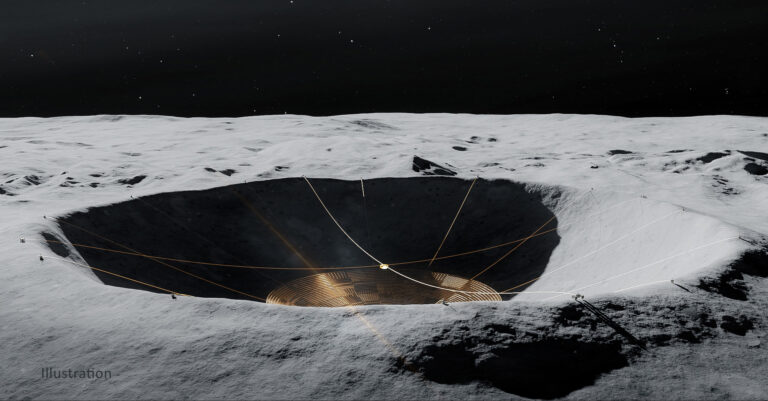For numerous years, predating the launch of the renowned Hubble telescope, astronomers have been launching spacecraft into orbit to avoid atmospheric disturbances that distort images taken by telescopes on the ground. However, even at these orbital altitudes, it is still challenging to obtain clear signals from certain cosmic entities.
Currently, astronomers are advocating for the placement of telescopes on the lunar surface. In a series of recently published studies, they propose that our celestial neighbor, particularly the far side of the moon, provides an ideal location for radio and infrared telescopes. These advanced instruments have the potential to detect and study planets outside our solar system that may have the ability to support life. Additionally, they can investigate the mysterious “dark ages” of the early universe, which occurred approximately one million years after the Big Bang when the first stars began to emerge.
Joseph Silk, a renowned astrophysicist from the University of Oxford and author of numerous scientific papers, strongly advocates for initiating discussions on lunar projects. With the global focus on lunar exploration, it is crucial to prioritize scientific endeavors in this field.
While Earth-based sensitive radio telescopes like the Low-Frequency Array (LOFAR) have been constructed, they face certain limitations. The Earth’s upper atmosphere hinders radio signals shorter than approximately 10 megahertz, which restricts the telescopes’ observational capabilities. Jack Burns, an astronomer at the University of Colorado and director of the Network for Exploration and Space Science, highlights another challenge posed by the proliferation of radio signals from human communication technologies such as cellphones, Wi-Fi, and satellites. These signals create interference that affects the telescopes’ performance. Although space-based telescopes offer improvements, they are still susceptible to interference even in orbit. Burns emphasizes that the far side of the Moon is the only region in the inner solar system that experiences true radio silence.
Jake Turner, an astronomer at Cornell University involved in ground-based telescopic observations, shares his dedication to devising methods to mitigate radio interference. Turner and his colleagues utilize radio astronomy to detect magnetic fields emitted by certain planets.
The presence of magnetic fields, which depend on a planet’s internal composition, can significantly impact its suitability for hosting life. Many exoplanets discovered so far orbit red dwarf stars, which emit substantial amounts of charged particles capable of eroding a planet’s atmosphere and posing a threat to potential life forms. A magnetic field acts as a protective barrier against these stellar phenomena.
Turner has developed methods to detect magnetic fields of large planets, but smaller Earth-sized planets emit radio waves too weak and at frequencies too short to cut through Earth’s atmospheric noise. A telescope on the Moon could use the Moon’s shielding to reduce Earth’s radio interference.
The FARSIDE mission, proposed by Burns, aims to deploy a robotic lunar rover with an antenna array to survey the sky at low radio frequencies. Goals include finding habitable planets by detecting magnetic fields and studying energetic particles from host stars. If approved by NASA, construction could start in the late 2020s.
While FARSIDE is a smaller mission compared to Earth’s large telescopes, Silk and colleagues believe future projects could involve building a large infrared telescope on the Moon. To operate efficiently, these telescopes need cool environments, which could be achieved by placing them in permanently shadowed areas like craters near the lunar south pole. This infrared telescope could detect faint planets and study their atmospheres.
Construction of lunar telescopes offers several advantages over their terrestrial counterparts. One major advantage is the immunity to terrestrial wind disturbances, which can often affect the clarity of observations on Earth. Additionally, the reduced gravitational forces on the moon allow for more stable and precise measurements.
Although the lunar far side is not observable from Earth, spacecraft like NASA’s Lunar Reconnaissance Orbiter have been instrumental in providing detailed terrain mapping, aiding in the selection of suitable sites for telescope construction. This information is crucial for ensuring optimal conditions for astronomical observations.
However, there are certain challenges that need to be addressed when constructing telescopes on the lunar surface. One such challenge is the accumulation of dust, which can interfere with the functioning of the telescopes. Moreover, seismic activity induced by meteor impacts poses another obstacle that needs to be taken into consideration.
Despite these challenges, the proximity of potential lunar bases can be advantageous for telescope maintenance and upgrades. Robots or astronauts can easily access the telescopes for necessary repairs or enhancements, ensuring their longevity and optimal performance.
Martin Elvis, a Harvard astrophysicist, raises another important concern regarding the limited availability of prime astronomical locations on the moon. Locations like the Peaks of Eternal Light, which offer continuous sunlight, are highly sought after by astronomers. Elvis predicts that disputes may arise over the allocation of these valuable sites.
To overcome these ethical and logistical hurdles, astronomers like Burns are actively collaborating with NASA’s Artemis program. This program aims to deploy landers, rovers, and eventually humans to the moon, opening up new possibilities for lunar exploration and the establishment of astronomical installations.
As we enter a new era of lunar exploration, the construction of lunar telescopes holds great promise for advancing our understanding of the universe. With the support of programs like Artemis, we can expect significant progress in our astronomical endeavors on the moon.
Do not forget to share your opinion with us to provide you with the best posts !




0 Comments